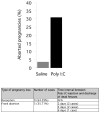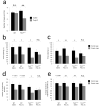Gestational immune activation and Tsc2 haploinsufficiency cooperate to disrupt fetal survival and may perturb social behavior in adult mice
- PMID: 21079609
- PMCID: PMC3118259
- DOI: 10.1038/mp.2010.115
Gestational immune activation and Tsc2 haploinsufficiency cooperate to disrupt fetal survival and may perturb social behavior in adult mice
Erratum in
- Mol Psychiatry. 2012 Apr;17(4):469
Abstract
Approximately 40-50% of individuals affected by tuberous sclerosis (TSC) develop autism spectrum disorders (ASDs). One possible explanation for this partial penetrance is an interaction between TSC gene mutations and other risk factors such as gestational immune activation. In this study, we report the interactive effects of these two ASD risk factors in a mouse model of TSC. Combined, but not single, exposure had adverse effects on intrauterine survival. Additionally, provisional results suggest that these factors synergize to disrupt social approach behavior in adult mice. Moreover, studies in human populations are consistent with an interaction between high seasonal flu activity in late gestation and TSC mutations in ASD. Taken together, our studies raise the possibility of a gene × environment interaction between heterozygous TSC gene mutations and gestational immune activation in the pathogenesis of TSC-related ASD.
Figures




Similar articles
-
Loss of Tsc2 in Purkinje cells is associated with autistic-like behavior in a mouse model of tuberous sclerosis complex.Neurobiol Dis. 2013 Mar;51:93-103. doi: 10.1016/j.nbd.2012.10.014. Epub 2012 Nov 1. Neurobiol Dis. 2013. PMID: 23123587
-
mTOR inhibitor reverses autistic-like social deficit behaviours in adult rats with both Tsc2 haploinsufficiency and developmental status epilepticus.Eur Arch Psychiatry Clin Neurosci. 2017 Aug;267(5):455-463. doi: 10.1007/s00406-016-0703-8. Epub 2016 Jun 4. Eur Arch Psychiatry Clin Neurosci. 2017. PMID: 27263037
-
Epilepsy and Tsc2 haploinsufficiency lead to autistic-like social deficit behaviors in rats.Behav Genet. 2011 May;41(3):364-72. doi: 10.1007/s10519-010-9399-0. Epub 2010 Oct 7. Behav Genet. 2011. PMID: 20927644
-
Mourning Dr. Alfred G. Knudson: the two-hit hypothesis, tumor suppressor genes, and the tuberous sclerosis complex.Cancer Sci. 2017 Jan;108(1):5-11. doi: 10.1111/cas.13116. Epub 2017 Jan 23. Cancer Sci. 2017. PMID: 27862655 Free PMC article. Review.
-
Behavioral analyses in rodent models of tuberous sclerosis complex.Epilepsy Behav. 2025 Apr;165:110313. doi: 10.1016/j.yebeh.2025.110313. Epub 2025 Feb 19. Epilepsy Behav. 2025. PMID: 39978075 Review.
Cited by
-
Development of home cage social behaviors in BALB/cJ vs. C57BL/6J mice.Behav Brain Res. 2013 Jan 15;237:338-47. doi: 10.1016/j.bbr.2012.08.051. Epub 2012 Sep 5. Behav Brain Res. 2013. PMID: 22982070 Free PMC article.
-
Gene-environment interaction counterbalances social impairment in mouse models of autism.Sci Rep. 2019 Aug 7;9(1):11490. doi: 10.1038/s41598-019-47680-w. Sci Rep. 2019. PMID: 31391512 Free PMC article.
-
Divergent dysregulation of gene expression in murine models of fragile X syndrome and tuberous sclerosis.Mol Autism. 2014 Feb 24;5(1):16. doi: 10.1186/2040-2392-5-16. Mol Autism. 2014. PMID: 24564913 Free PMC article.
-
Synaptic Alterations in a Transgenic Model of Tuberous Sclerosis Complex: Relevance to Autism Spectrum Disorders.Int J Mol Sci. 2021 Sep 17;22(18):10058. doi: 10.3390/ijms221810058. Int J Mol Sci. 2021. PMID: 34576223 Free PMC article.
-
Maternal genetic mutations as gestational and early life influences in producing psychiatric disease-like phenotypes in mice.Front Psychiatry. 2011 May 11;2:25. doi: 10.3389/fpsyt.2011.00025. eCollection 2011. Front Psychiatry. 2011. PMID: 21629836 Free PMC article.
References
-
- Kelleher RJ, 3rd, Bear MF. The autistic neuron: troubled translation? Cell. 2008;135(3):401–406. - PubMed
-
- Ehninger D, Silva AJ. Genetics and neuropsychiatric disorders: treatment during adulthood. Nat Med. 2009;15(8):849–850. - PubMed
-
- Fombonne E. Epidemiological surveys of autism and other pervasive developmental disorders: an update. J Autism Dev Disord. 2003;33(4):365–382. - PubMed
-
- Smalley SL. Autism and tuberous sclerosis. J Autism Dev Disord. 1998;28(5):407–414. - PubMed
-
- Smalley SL, Tanguay PE, Smith M, Gutierrez G. Autism and tuberous sclerosis. J Autism Dev Disord. 1992;22(3):339–355. - PubMed

